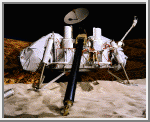|
COMETS EARTH JUPITER KUIPER BELT MARS MERCURY METEORITES NEPTUNE OORT CLOUD PLUTO SATURN SOLAR SYSTEM SPACE SUN URANUS VENUS ORDER PRINTS
PHOTO CATEGORIES SCIENCEVIEWS AMERICAN INDIAN AMPHIBIANS BIRDS BUGS FINE ART FOSSILS THE ISLANDS HISTORICAL PHOTOS MAMMALS OTHER PARKS PLANTS RELIGIOUS REPTILES SCIENCEVIEWS PRINTS
|
Related Document
Download Options
The first robotic spacecraft to land on Mars, the Vikings, were sent on a mission in 1975 to determine whether life had ever existed in any primitive biological form on the red planet. Scientif1c evidence by then strongly suggested that Mars had once been a planet with flowing rivers and a denser atmosphere. Only by direct sampling of the soil and atmosphere could the scientific community formulate a reasonable explanation for its evolutionary past and present state. Hence the first pair of orbiters and landers, Viking 1, were launched on August 20, 1975, followed on September 9 of that year by the second set, dubbed Viking 2. Viking 1 touched down in a moderately cratered, low-lying volcanic plain called Chryse Planitia, the drainage region of a large outflow channel. The landing site was 22.27 degrees north latitude and 47.97 degrees longitude in a barren desert of rocks and sand dunes. Viking 2 landed 6,460 kilometers (4,014 miles) away in Utopia Planitia, another rock-strewn desert at 47.67 degrees north latitude and 225.74 degrees longitude. The landers, managed by NASA's Langley Research Center in Hampton, Virginia, recorded slight seasonal variations in the landscape as summers tumed to winters. Above, the Viking orbiters, built by JPL, witnessed cloud layers forming as low- and high-pressure systems passed over the planet. The orbiters glimpsed changes in the color of the surface as dust was swept from region to region by the winds. |
